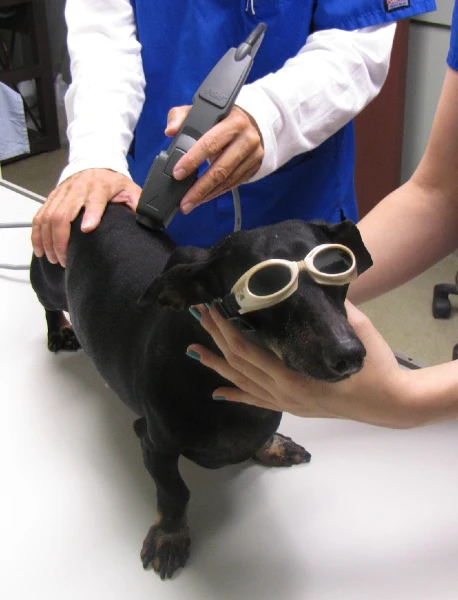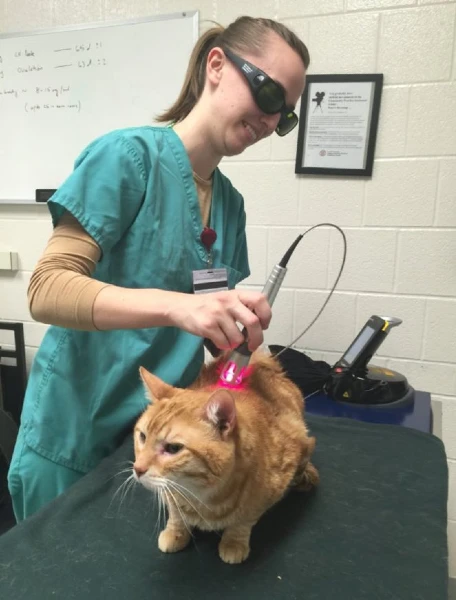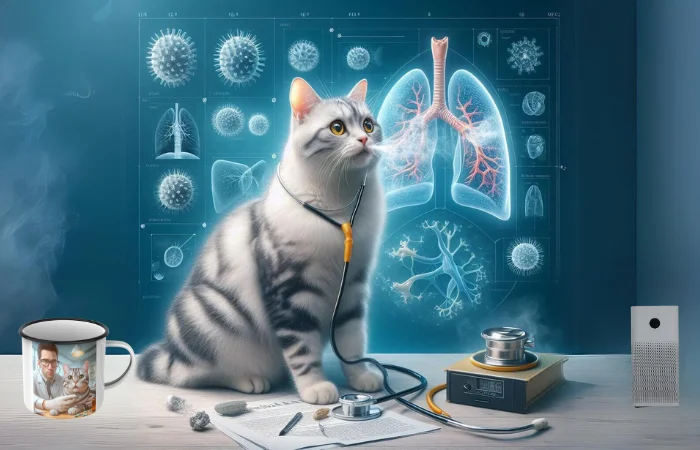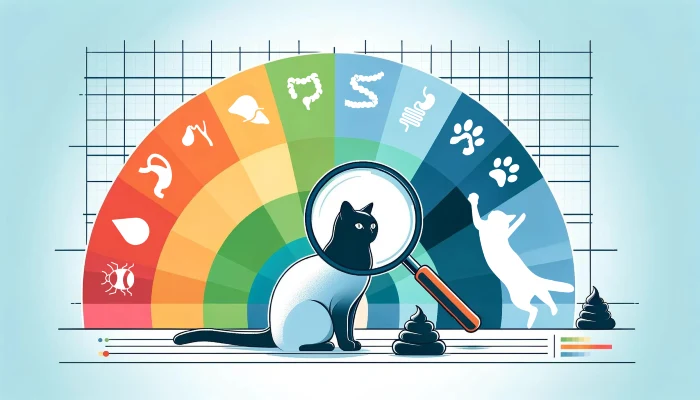In the world of healthcare, both human and animal, the age-old adage holds true: there’s more than one way to heal. As pet owners, we’re always on the hunt for ways to ensure our furry family members live long, happy, and healthy lives.
While traditional veterinary care plays a pivotal role, a surge of interest in alternative therapies for pets has begun to reshape our understanding of animal wellness.
From the ancient practices of the East to innovative, modern treatments, these therapies promise holistic healing, emphasizing the interconnectedness of body, mind, and spirit. Ready to dive deep into the world of alternative pet care? Let’s explore together.
The 10 Most Popular Alternative Therapies For Your Dog or Cat
1. Acupuncture
Acupuncture involves inserting thin needles into specific points on the body to stimulate healing and promote balance. This ancient Chinese practice has been used for thousands of years on humans and, more recently, has found its way into veterinary care.
Benefits:
- Provides pain relief, especially for arthritic or aging pets.
- Helps in improving gastrointestinal issues.
- Reduces inflammation and boosts the immune system.

Why Choose Acupuncture?
For pet owners looking for a non-invasive and drug-free treatment option, especially for chronic conditions or pain management, acupuncture can be an ideal choice. It’s particularly useful for pets that may not tolerate traditional medications.
Interesting Fact: In traditional Chinese medicine, acupuncture is believed to balance the flow of “Qi” (energy) through pathways known as meridians.
Average Cost: Depending on the location and the veterinarian’s expertise, a session can range from $50 to $150. Regular sessions might be required for optimal results.
2. Chiropractics
Chiropractic care for pets, like that for humans, involves adjusting the spine and joints to improve function and promote nerve health.
Benefits:
- Alleviates pain and stiffness.
- Improves mobility, especially in senior pets.
- Beneficial for pets recovering from injuries.
Why Choose Chiropractics?
Pet owners often turn to chiropractic care when they notice mobility issues in their pets. It’s a non-surgical option that can work in tandem with traditional veterinary care.
Interesting Fact: The term “chiropractic” is derived from the Greek words “cheir” (hand) and “praxis” (practice), to describe a treatment done by hand.
Average Cost: A chiropractic session for pets can vary widely, usually falling between $50 to $200. The cost might also depend on the severity of the pet’s condition.
3. Hydrotherapy
Hydrotherapy, or aquatic therapy, uses the therapeutic properties of water to rehabilitate and improve the physical condition of pets. This can take place in specially designed pools or treadmills submerged in water.
Benefits:
- Offers low-impact exercise, ideal for pets with joint issues.
- Aids in post-surgical rehabilitation.
- Enhances cardiovascular fitness and muscle strength.
Why Choose Hydrotherapy?
For pets that require exercise without putting strain on their joints, such as those with arthritis or hip dysplasia, hydrotherapy is a buoyant solution. It’s also beneficial for weight management in obese pets.
Interesting Fact: The buoyancy of water reduces weight-bearing stresses, allowing pets to move their joints in a fuller range than they might be able to on land.
Average Cost: A hydrotherapy session can range from $30 to $75, though this may vary depending on the duration and specific needs of the pet.
4. Low-Level Laser Therapy (LLLT)
Low-Level Laser Therapy, often referred to as cold laser therapy, employs specific wavelengths of light to interact with tissue, helping to accelerate the healing process. It can be used for a variety of conditions, including wounds, sprains, and chronic conditions.
Benefits:
- Reduces pain and inflammation.
- Stimulates injured cells, speeding up healing.
- Non-invasive with no side effects.


Why Choose LLLT?
If your pet suffers from chronic pain, arthritis, skin conditions, or wounds that are slow to heal, LLLT offers a non-pharmaceutical approach that complements other treatments.
Interesting Fact: Despite being called a “cold” laser, the therapy doesn’t involve cold temperatures. Instead, it’s termed “cold” because the levels of light aren’t high enough to heat body tissues.
Average Cost: The cost of LLLT can vary based on the condition and the number of treatments required, but generally, sessions range from $30 to $60.
5. Herbal Medicine
Rooted in ancient practices, herbal medicine involves using plants and their extracts to treat various ailments in pets.
Benefits:
- Addresses underlying causes of disease rather than just symptoms.
- Can be used for a broad range of conditions from digestive issues to anxiety.
- Often has fewer side effects than conventional medicine.
Why Choose Herbal Medicine?
For those looking for a more natural approach to pet health, especially for chronic conditions or preventative care, herbal medicine offers a holistic alternative.
Interesting Fact: Many modern medicines, including aspirin, trace their origins to herbal remedies. Aspirin, for instance, is derived from the willow tree.
Average Cost: Prices can vary widely based on the specific herbs and formulations, but generally, herbal remedies can range from $10 to $50 a month.
6. Homeopathy
Homeopathy is based on the principle that “like cures like”. It involves treating pets with minute doses of substances that, in larger amounts, would produce symptoms of the ailment.
Benefits:
- Focuses on the pet's overall well-being.
- Tailored to each individual animal.
- Minimal side effects.
Why Choose Homeopathy?
Pet owners drawn to holistic and individualized treatments might consider homeopathy, especially for chronic conditions not addressed by conventional medicine.
Interesting Fact: Homeopathy dates back to the late 1700s and was developed by Samuel Hahnemann, a German doctor who was dissatisfied with the medical practices of his time.
Average Cost: Homeopathic remedies themselves are relatively inexpensive, often between $10 to $30. However, consultations with a veterinary homeopath can range from $50 to $300.
7. Stem-Cell Therapy
Stem-cell therapy involves using the body’s own cells to repair and regenerate damaged tissues. For pets, it’s commonly used for degenerative joint diseases, but its applications are ever-expanding.
Benefits:
- Natural and minimally invasive.
- Can significantly improve the quality of life for pets with joint diseases.
- Potential applications in treating other conditions like spinal injuries.
Why Choose Stem-Cell Therapy?
For pets with conditions like osteoarthritis that don’t respond well to traditional treatments, stem-cell therapy offers a cutting-edge alternative.
Interesting Fact: The first recorded experiment related to stem cells dates to the early 1900s. Since then, the field has witnessed revolutionary advancements.
Average Cost: Given its specialized nature, stem-cell therapy can be on the pricier side, ranging from $1,500 to $3,000, which typically includes harvesting, processing, and the actual treatment.
8. Acupressure
Acupressure, a sister therapy to acupuncture, is rooted in Traditional Chinese Medicine. It involves applying pressure to specific points on the body to balance the flow of energy (Qi) and promote healing.
Benefits:
- Non-invasive, without the use of needles.
- Can alleviate pain, improve circulation, and balance energy flow.
- Addresses both physical and emotional ailments.
Why Choose Acupressure?
If your pet isn’t comfortable with acupuncture needles, but you want similar benefits, acupressure is an excellent choice. It’s particularly beneficial for older pets, anxious pets, or those with chronic conditions.
Interesting Fact: The art of acupressure is believed to be over 5,000 years old and serves as the foundation for many other therapeutic methods like reflexology and shiatsu.
Average Cost: Consultation and sessions with a qualified practitioner can range from $50 to $150, depending on the duration and frequency of treatments.
9. Massage Therapy
Pet massage therapy involves hands-on manipulation of muscles and soft tissues to promote relaxation, increase circulation, and reduce tension.
Benefits:
- Relieves stress and anxiety.
- Enhances flexibility and reduces muscle tension.
- Can speed up recovery after surgery or injury.
Why Choose Massage Therapy?
For pets that are active, aging, or recovering from surgery, massage can provide relief and relaxation. It’s also a wonderful way to bond with your pet.
Interesting Fact: Historical texts indicate that animal massage was used in ancient civilizations like Egypt and China. Today, it’s recognized as a professional practice with dedicated schools and certifications.
Average Cost: The cost of a pet massage session varies by region and the therapist’s qualifications, but prices generally range from $30 to $100 per session.
10. Osteopathy
Osteopathy is a hands-on holistic treatment that focuses on maintaining the relationships between the body’s structure and function. For pets, this involves ensuring the musculoskeletal system is in harmony.
Benefits:
- Addresses joint issues, digestive problems, and respiratory challenges.
- Emphasizes preventive care.
- Enhances overall mobility and health.
Why Choose Osteopathy?
If your pet has mobility issues, or if you’re looking for a preventive approach to health that goes beyond mere symptom treatment, osteopathy offers a comprehensive method.
Interesting Fact: Osteopathy was developed by Dr. Andrew Taylor Still in the late 1800s, initially for humans. The principles, however, were soon adapted for animal health, given the similarities in musculoskeletal systems.
Average Cost: Consultations and treatments with an animal osteopath can range from $70 to $200, depending on the complexity of the session and the practitioner’s expertise.
Our pets are more than just animals; they’re part of our families, our confidants, and our faithful companions. Investing in their health and well-being is truly an investment in love.
As we’ve seen, alternative therapies offer a plethora of options to address ailments, boost overall health, and improve quality of life.
More To Discover
- Pet Health Issues You Shouldn’t Ignore: Prevention is Better (and Cheaper) Than a Cure
- The Importance of Spaying and Neutering Pets: Overpopulation, Health, and Myths
- A Comprehensive Guide to Understanding and Maintaining Your Dog’s Ear Health
- The Importance of Your Pet’s Dental Health: More Than Just a Winning Smile
While these treatments can be beneficial, it’s always essential to consult with a veterinarian before diving into any new therapeutic regimen.
After all, each pet is unique, and their health plans should be, too.
Remember, whether you choose acupuncture, massage, osteopathy, or any other alternative therapy, the goal is a happy, healthy pet that enjoys every wag, purr, and playful moment with you.
























